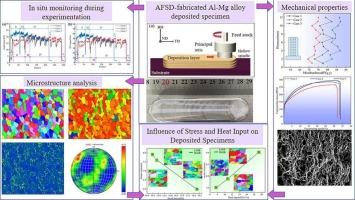Synergistic influence of rotational and travel speeds on microstructure and property in AlMg alloy via Additive Friction Stir Deposition
IF 5.5
2区 材料科学
Q1 MATERIALS SCIENCE, CHARACTERIZATION & TESTING
引用次数: 0
Abstract
Additive Friction Stir Deposition (AFSD), as a novel solid-state additive manufacturing (AM) process, demonstrates substantial potential for fabricating high-integrity components using lightweight aluminum alloys. In the present study, the synergistic effects of tool rotational speed and travel speed on the microstructural evolution and mechanical performance of AA5083 alloy manufactured via AFSD were systematically investigated. Real-time monitoring of axial force and spindle torque was employed to enable in situ evaluation of thermo-mechanical conditions, which were quantitatively correlated with heat input, strain accumulation, and the resultant tensile properties. This research approach revealed the underlying mechanisms through which coupled process parameters regulate dislocation activity, grain refinement, and strengthening behavior in AFSD-fabricated aluminum alloys. An increase in rotational speed resulted in elevated heat input, thereby facilitating dynamic recovery and grain coarsening. In contrast, a higher travel speed reduced thermal input while increasing plastic strain, which contributed to the formation of more refined microstructures. Under high heat input conditions (i.e., tool rotational speed of 800 rpm and travel speed of 200 mm/min), the deposited AA5083 alloy exhibited an average grain size of 8.47 μm, with an ultimate tensile strength (UTS) of 296.7 MPa and a yield strength (YS) of 137.2 MPa. Notably, dislocation accumulation was identified as the dominant strengthening mechanism under this condition. Under lower heat input and higher strain conditions (i.e., tool rotational speed of 600 rpm and travel speed of 280 mm/min), finer grains were achieved (with an average size of 6.75 μm), accompanied by a comparable UTS (295.0 MPa) and a slight improvement in YS (139.1 MPa). This improvement in YS is attributed to the synergistic contribution of dislocation strengthening and grain boundary strengthening. These results confirm that lower heat input combined with higher strain rates enhances microstructural refinement without compromising mechanical strength, thereby providing a viable strategy for optimizing the AFSD process of Al![]() Mg alloys. The findings of this study advance the understanding of process–structure–property relationships in AFSD-fabricated alloys and provide support for the development of tailored process parameter sets for high-performance structural applications.
Mg alloys. The findings of this study advance the understanding of process–structure–property relationships in AFSD-fabricated alloys and provide support for the development of tailored process parameter sets for high-performance structural applications.

转速和行程速度对添加搅拌摩擦沉积AlMg合金组织和性能的协同影响
添加剂搅拌摩擦沉积(AFSD)作为一种新型的固态增材制造(AM)工艺,在使用轻质铝合金制造高完整性部件方面显示出巨大的潜力。本文系统研究了刀具转速和行程速度对AFSD制备的AA5083合金组织演变和力学性能的协同效应。通过对轴向力和主轴扭矩的实时监测,可以对热-机械条件进行现场评估,这些条件与热输入、应变积累以及由此产生的拉伸性能定量相关。该研究方法揭示了耦合工艺参数调节afsd制备铝合金中位错活性、晶粒细化和强化行为的潜在机制。转速的增加导致热量输入的增加,从而促进动态恢复和晶粒粗化。相比之下,较高的行程速度减少了热输入,同时增加了塑性应变,这有助于形成更精细的微观组织。在高热输入条件下(即刀具转速为800 rpm,行程速度为200 mm/min),沉积的AA5083合金平均晶粒尺寸为8.47 μm,极限抗拉强度(UTS)为296.7 MPa,屈服强度(YS)为137.2 MPa。值得注意的是,在这种情况下,位错积累被确定为主要的强化机制。在较低的热输入和较高的应变条件下(即刀具转速为600 rpm,行程速度为280 mm/min),可以获得更细的晶粒(平均尺寸为6.75 μm),同时具有相当的UTS (295.0 MPa)和略有改善的YS (139.1 MPa)。YS的改善归因于位错强化和晶界强化的协同作用。这些结果证实,在不影响机械强度的情况下,较低的热输入结合较高的应变率可以提高显微组织的细化程度,从而为优化AlMg合金的AFSD工艺提供了可行的策略。这项研究的发现促进了对afsd制造合金的工艺-结构-性能关系的理解,并为高性能结构应用的定制工艺参数集的开发提供了支持。
本文章由计算机程序翻译,如有差异,请以英文原文为准。
求助全文
约1分钟内获得全文
求助全文
来源期刊

Materials Characterization
工程技术-材料科学:表征与测试
CiteScore
7.60
自引率
8.50%
发文量
746
审稿时长
36 days
期刊介绍:
Materials Characterization features original articles and state-of-the-art reviews on theoretical and practical aspects of the structure and behaviour of materials.
The Journal focuses on all characterization techniques, including all forms of microscopy (light, electron, acoustic, etc.,) and analysis (especially microanalysis and surface analytical techniques). Developments in both this wide range of techniques and their application to the quantification of the microstructure of materials are essential facets of the Journal.
The Journal provides the Materials Scientist/Engineer with up-to-date information on many types of materials with an underlying theme of explaining the behavior of materials using novel approaches. Materials covered by the journal include:
Metals & Alloys
Ceramics
Nanomaterials
Biomedical materials
Optical materials
Composites
Natural Materials.
 求助内容:
求助内容: 应助结果提醒方式:
应助结果提醒方式:


